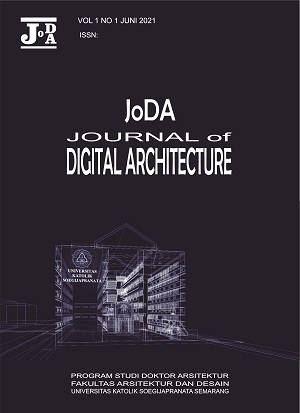Framework Optimasi Multi-Objektif dengan Metode Parametrik
Abstract
Performa bangunan merupakan isu yang sering dipertimbangkan dalam proses perancangan arsitektur. Pada prakteknya, pertimbangan ini seringkali bersifat multi-objektif sehingga pembuatan keputusan menjadi lebih rumit. Ketika masalah bersifat multi-objektif dan kompleks, pengambilan keputusan dengan hanya mengandalkan intuisi dan pengalaman perancang dapat menghasilkan solusi yang tidak tepat. Potensi metode parametrik berupa computer aided design yang dapat diintegrasikan dengan alat building performance simulation (BPS) dapat membantu perancang dalam memberi pertimbangan pengambilan keputusan. Studi ini bertujuan mengeksplorasi penggunaan metode parametrik sebagai alat bantu pengambilan keputusan melalui kasus studi optimasi kebisingan dan daylighting pada selasar basement gedung Thomas Aquinas UAJY. Output penelitian berupa pemaparan eksplorasi penggunaan metode parametrik beserta manfaat dan batasan yang ditemukan. Penelitian menggunakan software rhinoceros dan grashopper, ladybug, honeybee, pachyderm, colibri, dan design explorer. Berdasarkan hasil eksplorasi yang dilakukan, penggunaan metode parametrik memiliki manfaat dan batasan.
Keywords
Full Text:
PDFReferences
R. Oxman, “Performance-based Design: Current Practices and Research Issues,” Int. J. Archit. Comput., vol. 6, 2014, doi: 10.1260/147807708784640090.
Y. E. Kalay, “Performance-based design,” Autom. Constr. 8, pp. 395–409, 1999, [Online]. Available: https://www.academia.edu/25884247/Performance-based_design.
G. Draghici and F. Banciu, “Development of a conceptual design methodology for products,” Rom. J. Tech. Sci. Appl. Mech., vol. 49, pp. 575–578, 2004, doi: 10.13140/2.1.4537.7920.
N. C. Brown, “Early Building Design Using Multi-Objective Data Approaches,” Massachusetts Institute of Technology, 2019.
S. Li, L. Liu, and C. Peng, “A review of performance-oriented architectural design and optimization in the context of sustainability: Dividends and challenges,” Sustainability, vol. 12, no. 4, 2020, doi: 10.3390/su12041427.
K. Lam, N. Wong, and F. Henry, “A study of the use of performance-based simulation tools for building design and evaluation in Singapore,” Architecture, no. January, pp. 1–8, 1999, [Online]. Available: http://www.ibpsa.org/proceedings/BS1999/BS99_B-20.pdf.
B. Kiss and Z. Szalay, “Modular approach to multi-objective environmental optimization of buildings,” Autom. Constr., vol. 111, no. November 2019, p. 103044, 2020, doi: 10.1016/j.autcon.2019.103044.
A. T. Nguyen, S. Reiter, and P. Rigo, “A review on simulation-based optimization methods applied to building performance analysis,” Appl. Energy, vol. 113, no. January, pp. 1043–1058, 2014, doi: 10.1016/j.apenergy.2013.08.061.
S. H. E. Lin and D. J. Gerber, “Designing-in performance: A framework for evolutionary energy performance feedback in early stage design,” Autom. Constr., vol. 38, pp. 59–73, 2014, doi: 10.1016/j.autcon.2013.10.007.
T. Østergård, R. L. Jensen, and S. E. Maagaard, “Building simulations supporting decision making in early design - A review,” Renew. Sustain. Energy Rev., vol. 61, pp. 187–201, 2016, doi: 10.1016/j.rser.2016.03.045.
X. Shi, “Performance-driven architectural design and optimization technqiue from a perspective of architects,” Autom. Constr. 32, no. July 2013, pp. 125–135, 2019, doi: 10.1016/j.autcon.2013.01.015.
J. H. In Callender, Time-saver standards for architectural design data. New York: McGraw-Hill Science Engineering, 1974.
E. Touloupaki and T. Theodosiou, “Optimization of Building form to Minimize Energy Consumption through Parametric Modelling,” Procedia Environ. Sci., vol. 38, pp. 509–514, 2017, doi: 10.1016/j.proenv.2017.03.114.
M. Stavric and O. Marina, “Parametric Modeling for Advanced Architecture,” Int. J. Appl. Math. Informatics, vol. 5, no. 1, pp. 9–16, 2011, [Online]. Available: https://www.researchgate.net/publication/285467523.
B. Peters and T. Peters, “Introduction—Computing the Environment: Design Workflows for the Simulation of Sustainable Architecture,” in Computing the Environment: Digital Design Tools for Simulation and Visualisation of Sustainable Architecture, John Wiley & Sons, Ltd., 2018, pp. 1–13.
T. Wortmann and T. Schroepfer, “From optimization to performance-informed design,” Simul. Ser., vol. 51, no. 8, pp. 261–268, 2019, [Online]. Available: https://www.researchgate.net/publication/332407077_From_Optimization_to_Performance-Informed_Design_Simulation-based_Design_Tools_and_Methods_Architectural_Design_Optimization_Visualization_of_Optimization_Results.
E. Fuchkina, S. Schneider, S. Bertel, and I. Osintseva, “Design Space Exploration Framework,” eCAADe 36, vol. 2, no. PARAMETRIC MODELLING, pp. 367–376, 2015, [Online]. Available: http://papers.cumincad.org/cgi-bin/works/paper/ecaade2018_197.
“Colibri Release.” http://core.thorntontomasetti.com/colibri-release/ (accessed Oct. 18, 2020).
V. W. Egan, M. David;Olgyay, Architectural Lighting. Blacklick, Ohio, U.S.A: McGraw-Hill Science Engineering, 2001.
E. Badino, “Acoustic performance-based design: exploration of the effects of different geometries and acoustical properties of an urban façade on the mitigation of chatting noise in a street canyon,” Politecnico di Torino, 2018.
X. Shen, A. Singhvi, A. Mengual, M. Spastri, and V. Watson, “Evaluating the Multi-Objective Optimization Methodology for Performance-Based Building Design in Professional Practice,” 2018 Build. Perform. Anal. Conf. Simbuild, pp. 646–653, 2018, [Online]. Available: https://www.ashrae.org/File Library/Conferences/Specialty Conferences/2018 Building Performance Analysis Conference and SimBuild/Papers/C088.pdf.
W. Suyoto, A. Indraprastha, and H. W. Purbo, “Parametric Approach as a Tool for Decision-making in Planning and Design Process. Case study: Office Tower in Kebayoran Lama,” Procedia - Soc. Behav. Sci., vol. 184, no. August 2014, pp. 328–337, 2015, doi: 10.1016/j.sbspro.2015.05.098.
DOI: https://doi.org/10.24167/joda.v1i1.3477
Refbacks
- There are currently no refbacks.
JoDA Journal of Digital Architecture | e-ISSN: 2798-6896 | View My Stats


















